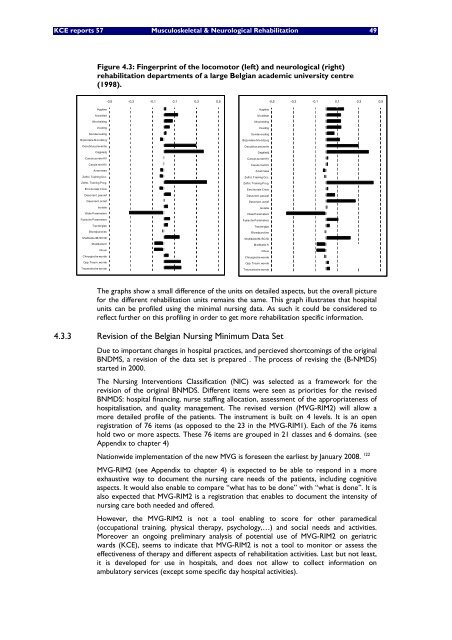The report is available in English with a French summary - KCE
The report is available in English with a French summary - KCE
The report is available in English with a French summary - KCE
You also want an ePaper? Increase the reach of your titles
YUMPU automatically turns print PDFs into web optimized ePapers that Google loves.
<strong>KCE</strong> <strong>report</strong>s 57 Musculoskeletal & Neurological Rehabilitation 49<br />
Hygiëne<br />
Mobiliteit<br />
Uitscheid<strong>in</strong>g<br />
Voed<strong>in</strong>g<br />
Sondevoed<strong>in</strong>g<br />
Bijzondere M ondzorg<br />
Decubitus preventie<br />
Dagkledij<br />
Canule zonder KV<br />
Canule met KV<br />
Anamnese<br />
Zelfst. Tra<strong>in</strong><strong>in</strong>g Occ.<br />
Zelfst. Tra<strong>in</strong><strong>in</strong>g Prog.<br />
Emotionele Cr<strong>is</strong><strong>is</strong><br />
Desorient. passief<br />
Desorient. actief<br />
Isolatie<br />
Vitale Parameters<br />
Fys<strong>is</strong>che Parameters<br />
Tractie/gips<br />
Bloedpuncties<br />
M edikatie IM /SC/ID<br />
M edikatie IV<br />
Infuus<br />
Chirurg<strong>is</strong>che wonde<br />
Opp. Traum. wonde<br />
Traumat<strong>is</strong>che wonde<br />
Figure 4.3: F<strong>in</strong>gerpr<strong>in</strong>t of the locomotor (left) and neurological (right)<br />
rehabilitation departments of a large Belgian academic university centre<br />
(1998).<br />
-0,5 -0,3 -0,1 0,1 0,3 0,5<br />
Hygiëne<br />
Mobiliteit<br />
Uitscheid<strong>in</strong>g<br />
Voed<strong>in</strong>g<br />
Sondevoed<strong>in</strong>g<br />
Bijzondere M ondzorg<br />
Decubitus preventie<br />
Dagkledij<br />
Canule zo nder KV<br />
Canule met KV<br />
Anamnese<br />
Zelfst. Tra<strong>in</strong><strong>in</strong>g Occ.<br />
Zelfst. Tra<strong>in</strong><strong>in</strong>g Prog.<br />
Emotionele Cr<strong>is</strong><strong>is</strong><br />
Deso rient. passief<br />
Desorient. actief<br />
Iso latie<br />
Vitale Parameters<br />
Fys<strong>is</strong>che Parameters<br />
Tractie/gips<br />
Bloedpuncties<br />
M edikatie IM /SC/ID<br />
M edikatie IV<br />
Infuus<br />
Chirurg<strong>is</strong>che wonde<br />
Opp. Traum. wonde<br />
Traumat<strong>is</strong>che wonde<br />
-0,5 -0,3 -0,1 0,1 0,3 0,5<br />
<strong>The</strong> graphs show a small difference of the units on detailed aspects, but the overall picture<br />
for the different rehabilitation units rema<strong>in</strong>s the same. Th<strong>is</strong> graph illustrates that hospital<br />
units can be profiled us<strong>in</strong>g the m<strong>in</strong>imal nurs<strong>in</strong>g data. As such it could be considered to<br />
reflect further on th<strong>is</strong> profil<strong>in</strong>g <strong>in</strong> order to get more rehabilitation specific <strong>in</strong>formation.<br />
4.3.3 Rev<strong>is</strong>ion of the Belgian Nurs<strong>in</strong>g M<strong>in</strong>imum Data Set<br />
Due to important changes <strong>in</strong> hospital practices, and percieved shortcom<strong>in</strong>gs of the orig<strong>in</strong>al<br />
BNDMS, a rev<strong>is</strong>ion of the data set <strong>is</strong> prepared . <strong>The</strong> process of rev<strong>is</strong><strong>in</strong>g the (B-NMDS)<br />
started <strong>in</strong> 2000.<br />
<strong>The</strong> Nurs<strong>in</strong>g Interventions Classification (NIC) was selected as a framework for the<br />
rev<strong>is</strong>ion of the orig<strong>in</strong>al BNMDS. Different items were seen as priorities for the rev<strong>is</strong>ed<br />
BNMDS: hospital f<strong>in</strong>anc<strong>in</strong>g, nurse staff<strong>in</strong>g allocation, assessment of the appropriateness of<br />
hospital<strong>is</strong>ation, and quality management. <strong>The</strong> rev<strong>is</strong>ed version (MVG-RIM2) will allow a<br />
more detailed profile of the patients. <strong>The</strong> <strong>in</strong>strument <strong>is</strong> built on 4 levels. It <strong>is</strong> an open<br />
reg<strong>is</strong>tration of 76 items (as opposed to the 23 <strong>in</strong> the MVG-RIM1). Each of the 76 items<br />
hold two or more aspects. <strong>The</strong>se 76 items are grouped <strong>in</strong> 21 classes and 6 doma<strong>in</strong>s. (see<br />
Appendix to chapter 4)<br />
Nationwide implementation of the new MVG <strong>is</strong> foreseen the earliest by January 2008. 122<br />
MVG-RIM2 (see Appendix to chapter 4) <strong>is</strong> expected to be able to respond <strong>in</strong> a more<br />
exhaustive way to document the nurs<strong>in</strong>g care needs of the patients, <strong>in</strong>clud<strong>in</strong>g cognitive<br />
aspects. It would also enable to compare “what has to be done” <strong>with</strong> “what <strong>is</strong> done”. It <strong>is</strong><br />
also expected that MVG-RIM2 <strong>is</strong> a reg<strong>is</strong>tration that enables to document the <strong>in</strong>tensity of<br />
nurs<strong>in</strong>g care both needed and offered.<br />
However, the MVG-RIM2 <strong>is</strong> not a tool enabl<strong>in</strong>g to score for other paramedical<br />
(occupational tra<strong>in</strong><strong>in</strong>g, physical therapy, psychology,…) and social needs and activities.<br />
Moreover an ongo<strong>in</strong>g prelim<strong>in</strong>ary analys<strong>is</strong> of potential use of MVG-RIM2 on geriatric<br />
wards (<strong>KCE</strong>), seems to <strong>in</strong>dicate that MVG-RIM2 <strong>is</strong> not a tool to monitor or assess the<br />
effectiveness of therapy and different aspects of rehabilitation activities. Last but not least,<br />
it <strong>is</strong> developed for use <strong>in</strong> hospitals, and does not allow to collect <strong>in</strong>formation on<br />
ambulatory services (except some specific day hospital activities).

















